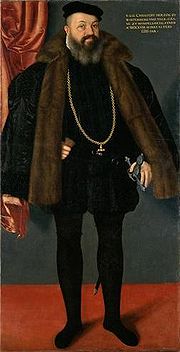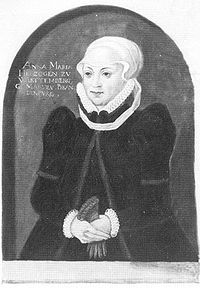
Christoph, Duke of Württemberg
Encyclopedia

Bad Urach
Bad Urach is a town in the district of Reutlingen, Baden-Württemberg, Germany. It is situated 14 km east of Reutlingen, at the foot of the Swabian Alb, and is known for its spa and therapeutic bath.-History:...
– 28 December 1568 Stuttgart
Stuttgart
Stuttgart is the capital of the state of Baden-Württemberg in southern Germany. The sixth-largest city in Germany, Stuttgart has a population of 600,038 while the metropolitan area has a population of 5.3 million ....
) ruled as Duke of Württemberg
Württemberg
Württemberg , formerly known as Wirtemberg or Wurtemberg, is an area and a former state in southwestern Germany, including parts of the regions Swabia and Franconia....
from 1550 until his death in 1568.
In November 1515, only months after his birth, his mother, Sabina of Bavaria
Sabina of Bavaria
Sabina of Bavaria-Munich was born Duchess of Bavaria and became wife of Ulrich, Duke of Württemberg.-Family:...
, fled to the court of her parents in Munich
Munich
Munich The city's motto is "" . Before 2006, it was "Weltstadt mit Herz" . Its native name, , is derived from the Old High German Munichen, meaning "by the monks' place". The city's name derives from the monks of the Benedictine order who founded the city; hence the monk depicted on the city's coat...
. Young Christoph stayed in Stuttgart with his elder sister Anna and his father, Duke Ulrich
Ulrich, Duke of Württemberg
Herzog Ulrich von Württemberg succeeded his kinsman Eberhard II as Duke of Württemberg in 1498, being declared of age in 1503.-Early life:...
. When the Swabian League
Swabian League
The Swabian League was an association of Imperial States - cities, prelates, principalities and knights - principally in the territory of the Early medieval stem duchy of Swabia, established in 1488 at the behest of Emperor Frederick III of Habsburg and supported as well by Bertold von...
mobilized troops against Ulrich, he brought them to Castle Hohentübingen. In 1519 Württemberg came under Austrian rule after the castle had surrendered and Duke Ulrich had been banished.
Christoph was sent to the court of Maximilian I
Maximilian I, Holy Roman Emperor
Maximilian I , the son of Frederick III, Holy Roman Emperor and Eleanor of Portugal, was King of the Romans from 1486 and Holy Roman Emperor from 1493 until his death, though he was never in fact crowned by the Pope, the journey to Rome always being too risky...
in Innsbruck
Innsbruck
- Main sights :- Buildings :*Golden Roof*Kaiserliche Hofburg *Hofkirche with the cenotaph of Maximilian I, Holy Roman Emperor*Altes Landhaus...
where he grew up and was able to gain political experience under Habsburg
Habsburg
The House of Habsburg , also found as Hapsburg, and also known as House of Austria is one of the most important royal houses of Europe and is best known for being an origin of all of the formally elected Holy Roman Emperors between 1438 and 1740, as well as rulers of the Austrian Empire and...
-tutelage. The successor of Maximilian I, Charles V
Charles V, Holy Roman Emperor
Charles V was ruler of the Holy Roman Empire from 1519 and, as Charles I, of the Spanish Empire from 1516 until his voluntary retirement and abdication in favor of his younger brother Ferdinand I and his son Philip II in 1556.As...
took him on his travels through Europe.
Meanwhile his father Ulrich had regained Württemberg from the Austria
Austria
Austria , officially the Republic of Austria , is a landlocked country of roughly 8.4 million people in Central Europe. It is bordered by the Czech Republic and Germany to the north, Slovakia and Hungary to the east, Slovenia and Italy to the south, and Switzerland and Liechtenstein to the...
ns in 1534 and Christoph was sent to the French court, where he became embroiled in France's wars against Habsburg. At the end of the 1530s Christoph converted to protestantism
Protestantism
Protestantism is one of the three major groupings within Christianity. It is a movement that began in Germany in the early 16th century as a reaction against medieval Roman Catholic doctrines and practices, especially in regards to salvation, justification, and ecclesiology.The doctrines of the...
. In 1542 the Treaty of Reichenweier installed him as the governor of the Württemberg region of Montbéliard
Montbéliard
Montbéliard is a city in the Doubs department in the Franche-Comté region in eastern France. It is one of the two subprefectures of the department.-History:...
.
In 1544 he married Anna Maria von Brandenburg-Ansbach
Anna Maria von Brandenburg-Ansbach
Anna Maria von Brandenburg-Ansbach was a German princess of Brandenburg-Ansbach.Anna Maria was born at Jägerndorf, the eldest daughter of George, Margrave of Brandenburg-Ansbach and his second wife Hedwig of Münsterberg-Oels, daughter of Charles I of Münsterberg-Oels...
(28 December 1526-20 May 1589), daughter of Georg, Margrave of Brandenburg-Ansbach, with whom he fathered twelve children.


- Eberhard ( 7 January 1545- 2 May 1568)
- HedwigDuchess Hedwig of WürttembergDuchess Hedwig of Württemberg was a princess of Württemberg by birth, and by marriage countess of Hesse-Marburg.- Life :Hedwig was the eldest daughter of the Duke Christopher of Württemberg...
(15 May 1547- 4 March 1590) - married Louis IV, Landgrave of Hesse-MarburgLouis IV, Landgrave of Hesse-MarburgLandgrave Louis IV of Hesse-Marburg was the son of Landgrave Philip I of Hesse and his wife Christine of Saxony. After the death of his father in 1567, Hesse was divided among his sons and Louis received Hesse-Marburg including Marburg and Giessen.Louis received his education at the court of... - Elisabeth ( 3 March 1548-28 February 1592) - married (1) Georg Ernst (1511-1583), Count von Henneberg-Schleusingen; (2) Georg Gustav (1564-1634), Count Palatine of Veldenz-Lauterecken
- SabineDuchess Sabine of WürttembergSabine of Württemberg was a princess of Württemberg by birth and by marriage, the first Landgravine of Hesse-Kassel.- Life :...
( 2 July 1549-17 August 1582) - married William IV, Landgrave of Hesse-KasselWilliam IV, Landgrave of Hesse-KasselWilliam IV of Hesse-Kassel , also called William the Wise, was the first Landgrave of Hesse-Kassel . He was the founder of the oldest line, which survives to this day.-Life:... - Emilie (19 August 1550- 4 June 1589) - married Reichard (1521-1598), Count Palatine of Simmern-Sponheim
- Eleonore (22 March 1552-12 January 1618) - married Joachim Ernest, Prince of AnhaltJoachim Ernest, Prince of AnhaltJoachim Ernest of Anhalt , was a German prince of the House of Ascania, ruler of the principality of Anhalt-Zerbst, and from 1570 sole ruler of all the Anhalt lands....
; (2) George I, Landgrave of Hesse-DarmstadtGeorge I, Landgrave of Hesse-DarmstadtGeorge I of Hesse-Darmstadt was the Landgrave of Hesse-Darmstadt from 1567 to 1596.Born on 10 September 1547 in Kassel, he was the fourth son of Philip I the Magnanimous of Hesse and Christine of Saxony.... - Ludwig ILudwig III, Duke of WürttembergLudwig, or Ludwig der Fromme, was a German nobleman. He was the fifth Duke of Württemberg from 1568 until his death.-Life:...
( 1 January 1554- 8 August 1593) - succeeded as Duke of Württemberg - Maximilian (27 August 1556-17 March 1557)
- Ulrich (?? May 1558- 7 July 1558)
- Dorothea Maria ( 3 September 1559-23 March 1639) - married Otto Heinrich, Count Palatine of SulzbachOtto Henry, Count Palatine of SulzbachOtto Henry of Sulzbach was the Count Palatine of Sulzbach from 1569 until 1604.-Life:Otto Henry was born in Amberg in 1556 as one of five sons of Wolfgang, Count Palatine of Zweibrücken. After his father's death in 1569, his lands were partitioned between Otto Henry and his four brothers - Otto...
- Anna (12 June 1561- 7 July 1616) - married (1) Duke John George of Oława; (2) Duke Frederick IV of LegnicaFrederick IV of LegnicaFrederick IV of Liegnitz was Duke of Liegnitz since 1571 until his death ....
- Sophie (20 November 1563-21 July 1590) - married Friedrich Wilhelm I, Duke of Saxe-Weimar
On succeeding his father in 1550, Christoph was forced to make high payments to avoid charges of treason by King Ferdinand I
Ferdinand I, Holy Roman Emperor
Ferdinand I was Holy Roman Emperor from 1558 and king of Bohemia and Hungary from 1526 until his death. Before his accession, he ruled the Austrian hereditary lands of the Habsburgs in the name of his elder brother, Charles V, Holy Roman Emperor.The key events during his reign were the contest...
.
In subsequent years, he re-organized the entire administration of the church and state. He also reformed and supported the educational system.
Christoph went to great efforts to boost Württemberg's profile. For example, he reconstructed the Altes Schloss
Old Castle (Stuttgart)
The Old Castle is located in the centre of Stuttgart, the capital of the German State of Baden-Württemberg. It dates back to the 10th century....
in Stuttgart and hosted many celebrations.

